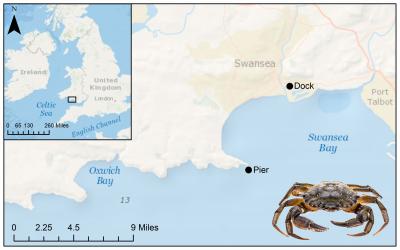Comprehensive new study

Credit: BlueFish Project, Swansea University
Shore crabs carry parasites that pose a major threat to shellfish stocks. In a new study, Swansea University researchers have used several different detection methods, including taking DNA from seawater, to build up the first comprehensive picture of the problem.
The common European shore crab is native to the UK, Ireland and the north east Atlantic. It shares this habitat with lots of species which are commercially very important, such as the edible crab and langoustines.
However, the shore crab is also a very invasive species as it can survive in a wide range of different environments. The species has now spread to the USA, South Africa and Australia, amongst other places.
These factors combined mean that the shore crab could pose a threat to the shellfish industry in terms of disease transmission. Fishing for edible crabs in the UK and Ireland alone is a £50 million industry.
Understanding more about the diseases borne by shore crabs is therefore critical, which is where the Swansea University research comes in.
The team, from the BlueFish project in the University’s Biosciences department, examined over 1200 crabs which they gathered over a one-year period from two locations, Mumbles Pier and Prince of Wales dock, in Swansea Bay.
They were looking for evidence of one particularly damaging parasite, called Hematodinium, to establish how extensively and how severely the crabs in the study were infected.
They used a range of testing methods, analysing blood smears, tissue from the crabs through histology, and examining their DNA using a technique called PCR (polymerase chain reaction), which allows them to make several copies of a specific DNA segment.
They also used environmental DNA, a relatively new technique which involves taking DNA from the surrounding seawater. This means they can look for evidence of the parasite even before it infects the crab, allowing them to build up a picture of the complete life cycle of the parasite.
The researchers found:
- 13.6% of the crabs tested were infected with the parasite Hematodinium
- The rate was 17.6% for male crabs and 9.3% for females
- The peak rate of infection was recorded in spring
- Seawater samples revealed evidence of the early stages of the parasite in development which was not yet found in the crabs themselves.
The researchers underlined that their work showed that multiple detection methods were crucial in building up an accurate picture of diseases. In particular, environmental DNA analysis was essential in understanding and tracking the whole life cycle of the parasite.
Dr Charlotte Eve Davies from Swansea University College of Science, Scientific Officer on the Bluefish project, said:
“Outbreaks of disease can devastate shellfish stocks and the livelihoods of people in the sector.
That’s why it is so important to understand the role of the shore crab in hosting the parasites and carrying disease.
The systematic approach we used, employing different detection methods, is vital in getting the best possible picture of the problem. In particular, the use of environmental DNA is useful in identifying possible pre-host stages in the life cycle of the parasite.”
###
The research was published open access in the journal Parasites and Vectors. The BlueFish Project has been funded by the European Regional Development Fund through the Ireland-Wales Co-operation Programme 2014-2020, a cross-border programme investing in the overall economic, environmental and social well-being of Ireland and Wales.
Notes to editors:
Read the research paper: “Spatial and temporal disease dynamics of the parasite Hematodinium sp. in shore crabs, Carcinus maenas”. Charlotte E. Davies , Frederico M. Batista, Sophie H. Malkin, Jessica E. Thomas, Charlotte C. Bryan, Peter Crocombe, Christopher J. Coates and Andrew F. Rowley. Published in Parasites and Vectors.
Swansea University is a world-class, research-led, dual campus university offering a first class student experience and has one of the best employability rates of graduates in the UK. The University has the highest possible rating for teaching – the Gold rating in the Teaching Excellence Framework (TEF) in 2018 and was commended for its high proportions of students achieving consistently outstanding outcomes.
Swansea climbed 14 places to 31st in the Guardian University Guide 2019, making us Wales’ top ranked university, with one of the best success rates of graduates gaining employment in the UK and the same overall satisfaction level as the Number 1 ranked university. The 2014 Research Excellence Framework (REF) 2014 results saw Swansea make the ‘biggest leap among research-intensive institutions’ in the UK (Times Higher Education, December 2014) and achieved its ambition to be a top 30 research University, soaring up the league table to 26th in the UK.
The University is in the top 300 best universities in the world, ranked in the 251-300 group in The Times Higher Education World University rankings 2018. Swansea University now has 23 main partners, awarding joint degrees and post-graduate qualifications.
The University was established in 1920 and was the first campus university in the UK. It currently offers around 350 undergraduate courses and 350 postgraduate courses to circa 20,000 undergraduate and postgraduate students.
The University has ambitious expansion plans as it moves towards its centenary in 2020 and aims to continue to extend its global reach and realise its domestic and international potential.
Swansea University is a registered charity. No.1138342. Visit http://www.
When reporting this story, please use Swansea University hyperlinks.
For more information:
Kevin Sullivan,Swansea University Public Relations Office
Tel: 01792 513245, [email protected]
Twitter: http://www.
Facebook: http://www.
Media Contact
Kevin Sullivan
[email protected]
01-792-513-245




